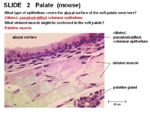Difference between revisions of "Soft Palate"
Jump to navigation
Jump to search
| Line 20: | Line 20: | ||
[[Image:Soft Palate Mouse.jpg|thumb|right|150px|Soft Palate (Mouse) - Copyright RVC 2008]] | [[Image:Soft Palate Mouse.jpg|thumb|right|150px|Soft Palate (Mouse) - Copyright RVC 2008]] | ||
| − | *Respiratory mucosa- ciliated pseudostratified columnar epithelium on aboral surface | + | *Respiratory mucosa - ciliated pseudostratified columnar epithelium on aboral surface |
*Stratified squamous epithelium on oral surface | *Stratified squamous epithelium on oral surface | ||
*[[Palatine|Palatine]] salivary glands | *[[Palatine|Palatine]] salivary glands | ||
| − | |||
==Musculature and Innervation== | ==Musculature and Innervation== | ||
Revision as of 15:33, 18 July 2008
Introduction
The soft palate (velum palatine) is located caudally to the hard palate. It is comprised of muscle and is involved in tasting food and in deglutition.
Structure and Function
- Muscle
- Contacts epiglottis caudally
- Very folded mucosa
- Striated palatine muscle
Histology
- Respiratory mucosa - ciliated pseudostratified columnar epithelium on aboral surface
- Stratified squamous epithelium on oral surface
- Palatine salivary glands
Musculature and Innervation
- Sensation and taste from glossopharyngeal (CN IX)
- Palatine muscle
-Origin: hard palate transeverse ridges -Insertion: soft palate -Shortens palate -Major innervation from vagus nerve (CN X) and minor from glossopgaryngeal nerve (CN IX)
- Tensor velli palatini
-Origin: near tympanic bulla on temporal bone -Insertion: lateral aponeurosis -Pharyngeal arch 1 -Mandibular of trigeminal (CN V3) -Tenses soft palate
- Levator velli palatini
-Origin: near tympanic bulla on temporal bone -Insertion: lateral aponeurosis -Raises soft palate -Major innervation from vagus nerve (CN X) and minor from glossopgaryngeal nerve (CN IX)
- Palatopharyngeus
-closes palatopharyngeal arch and therefore lift soft palate -Major innervation from vagus nerve (CN X) and minor from glossopgaryngeal nerve (CN IX)
Species Differences
Porcine
- Soft palate does not contact the epiglottis in the pig as the porcine soft palate is raised higher in the oral cavity than in other species
Equine
- Horses have a tight laryngeal cuff around the laryngeal entrance therefore cannot lift their soft palate for long periods of time and thus are nasal breathers
Canine
- As brachiocephalic dog breeds have a shortened skull length, the soft palate often obstruct air flow into the larynx causing breathing difficulties
Avian
- Birds lack a soft palate
